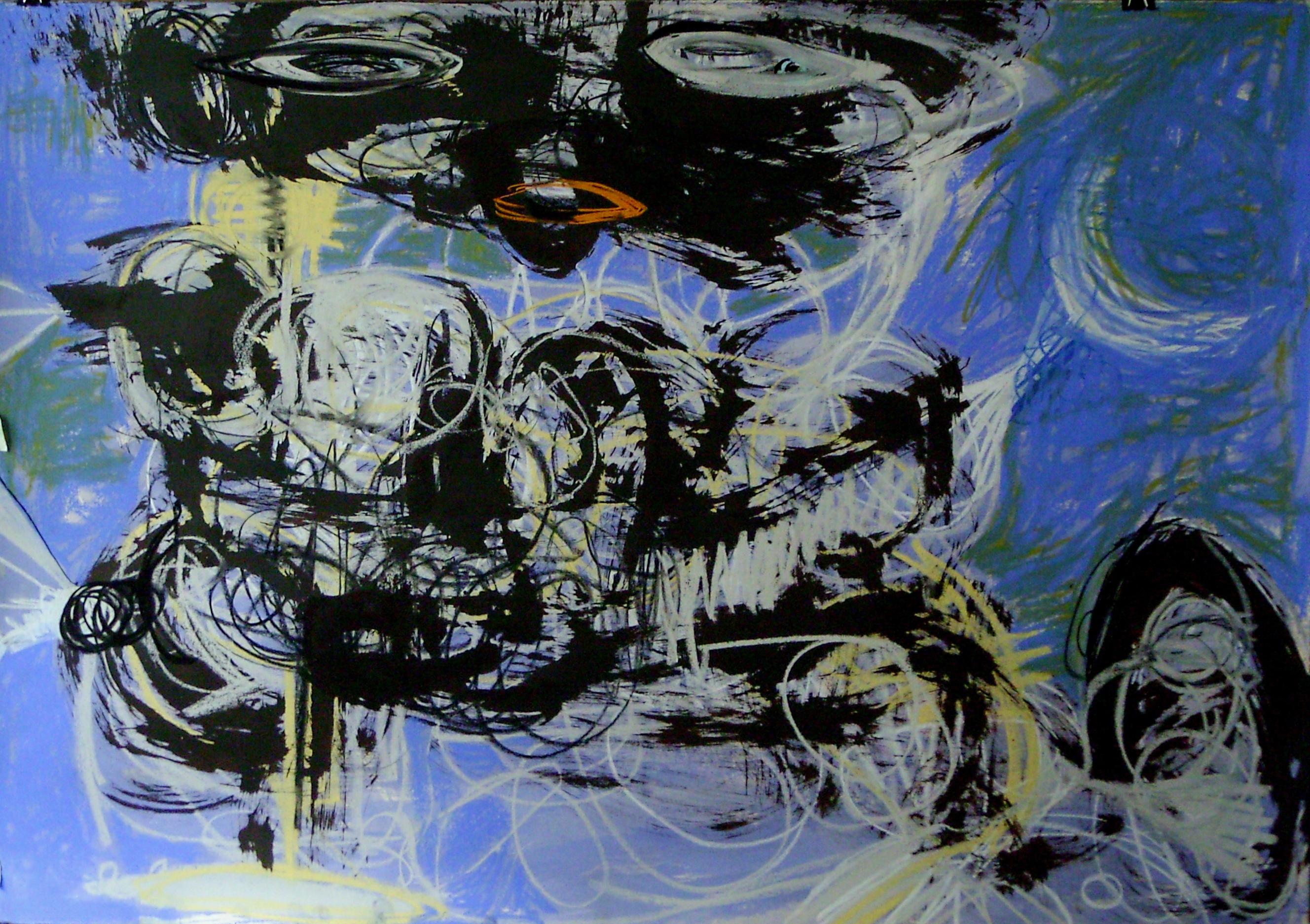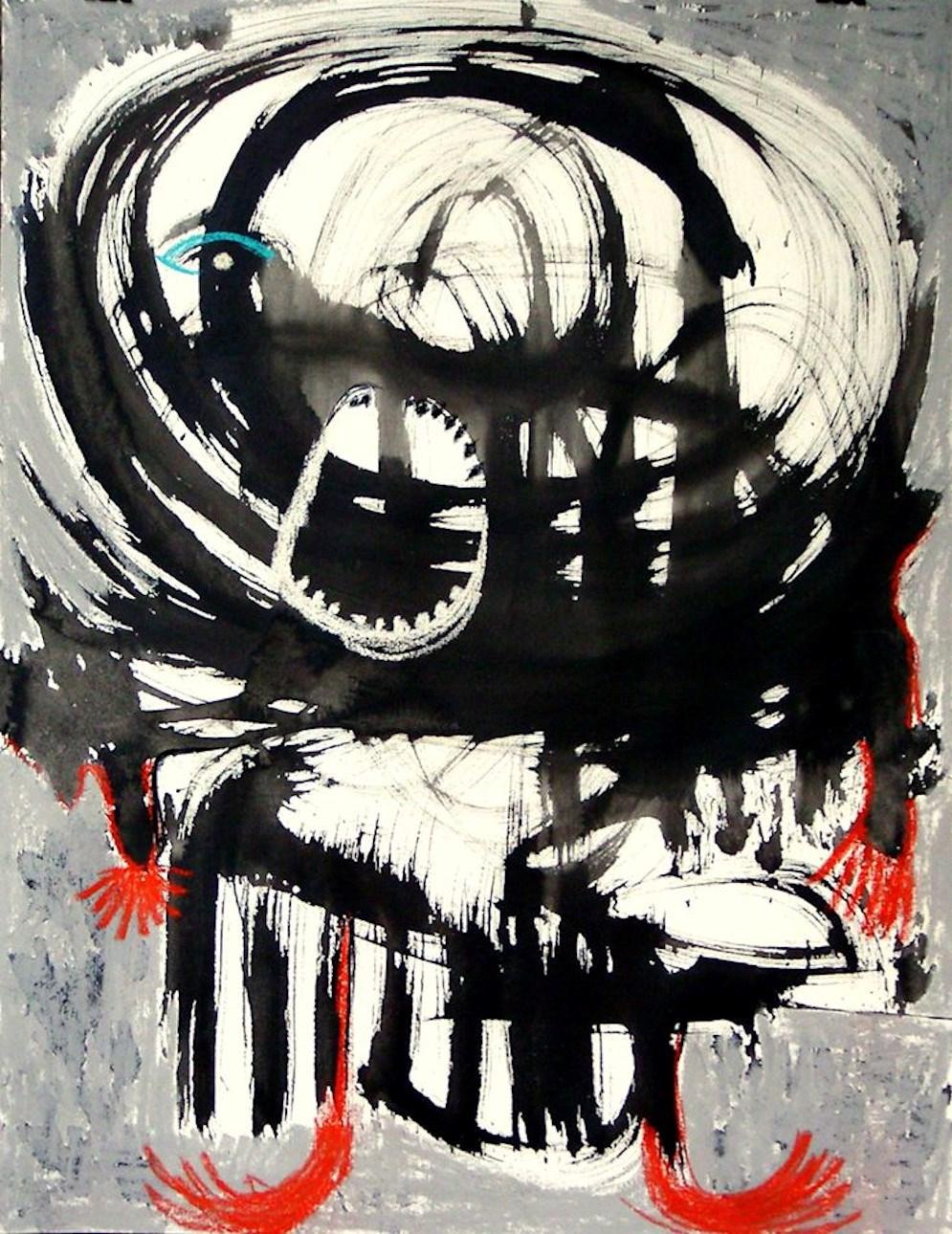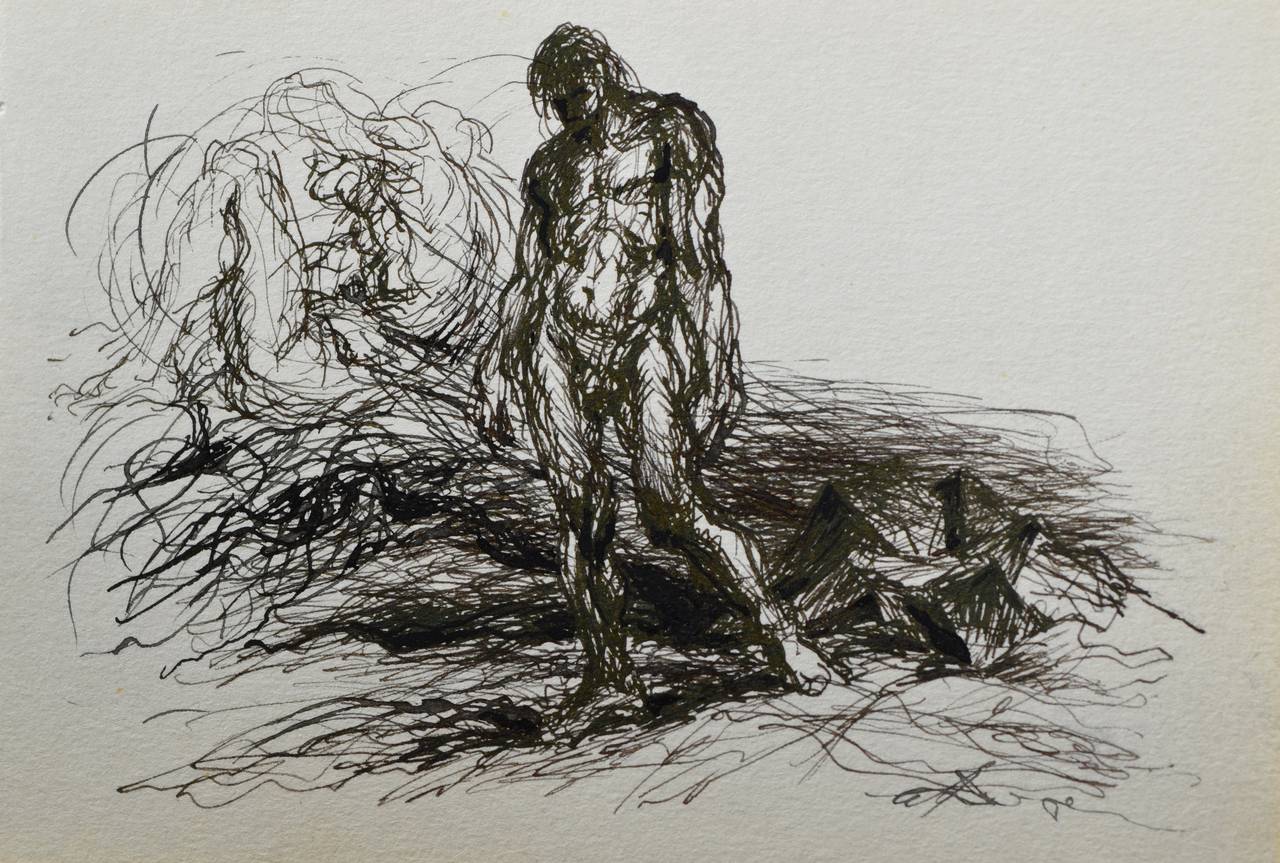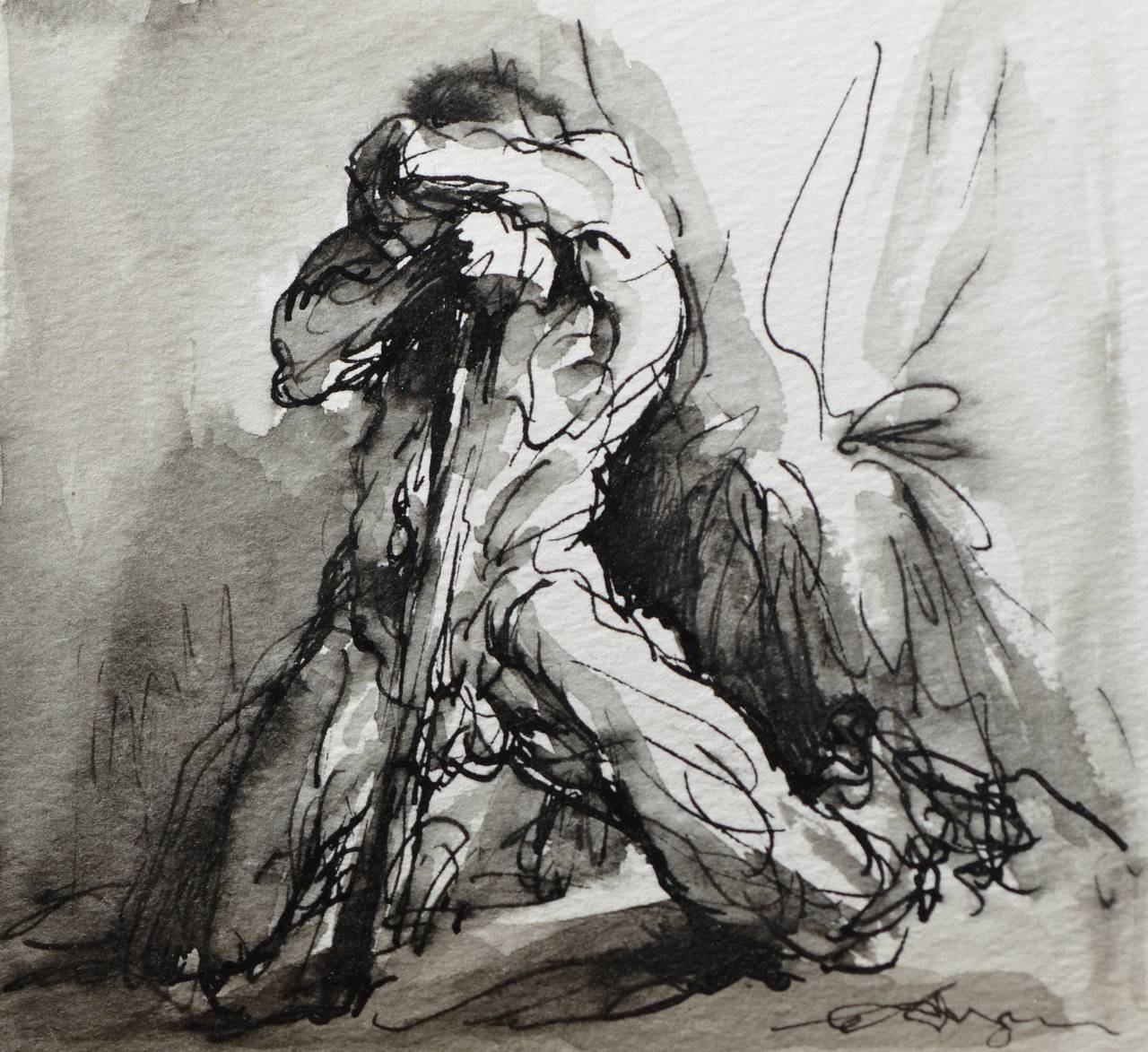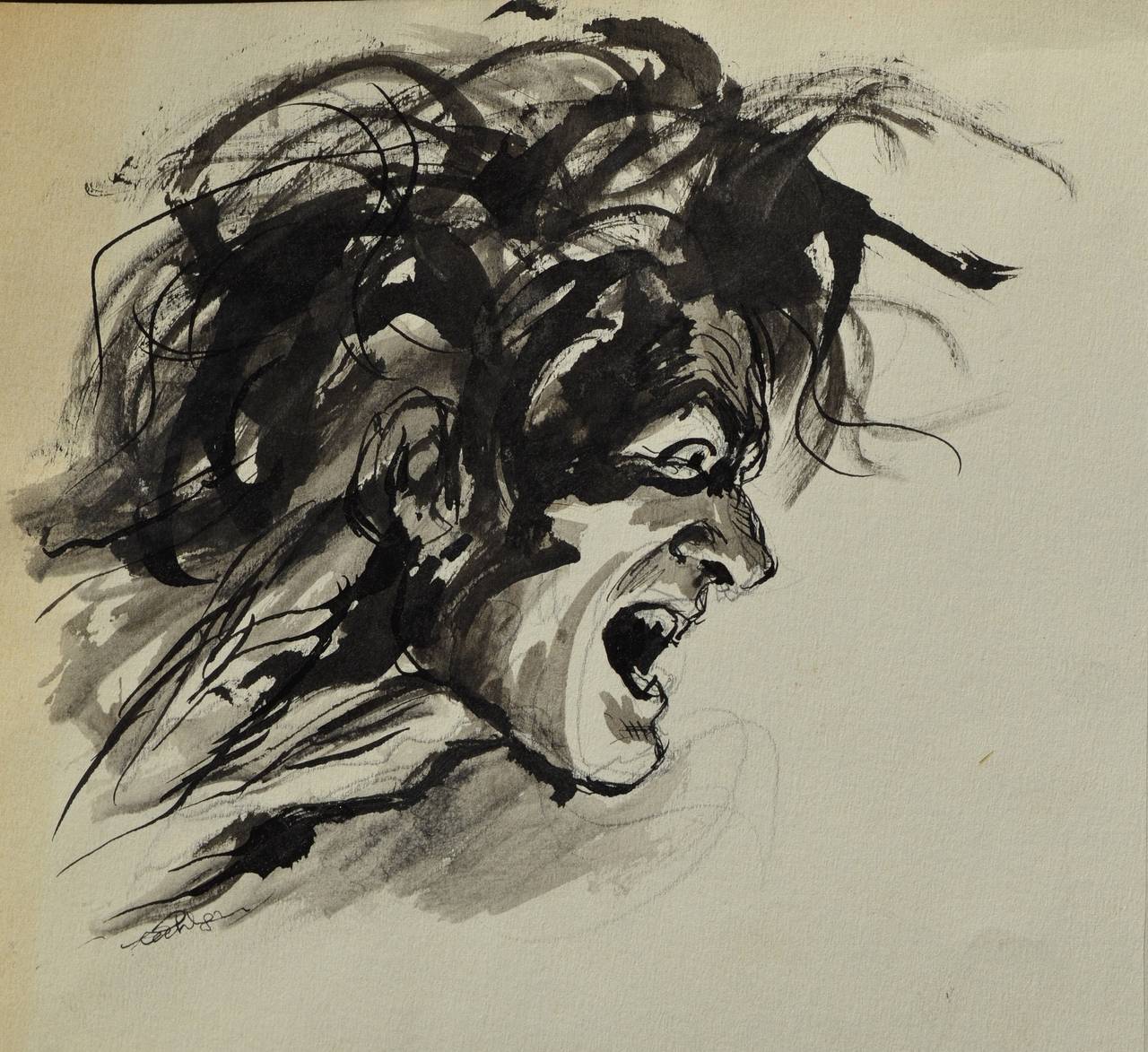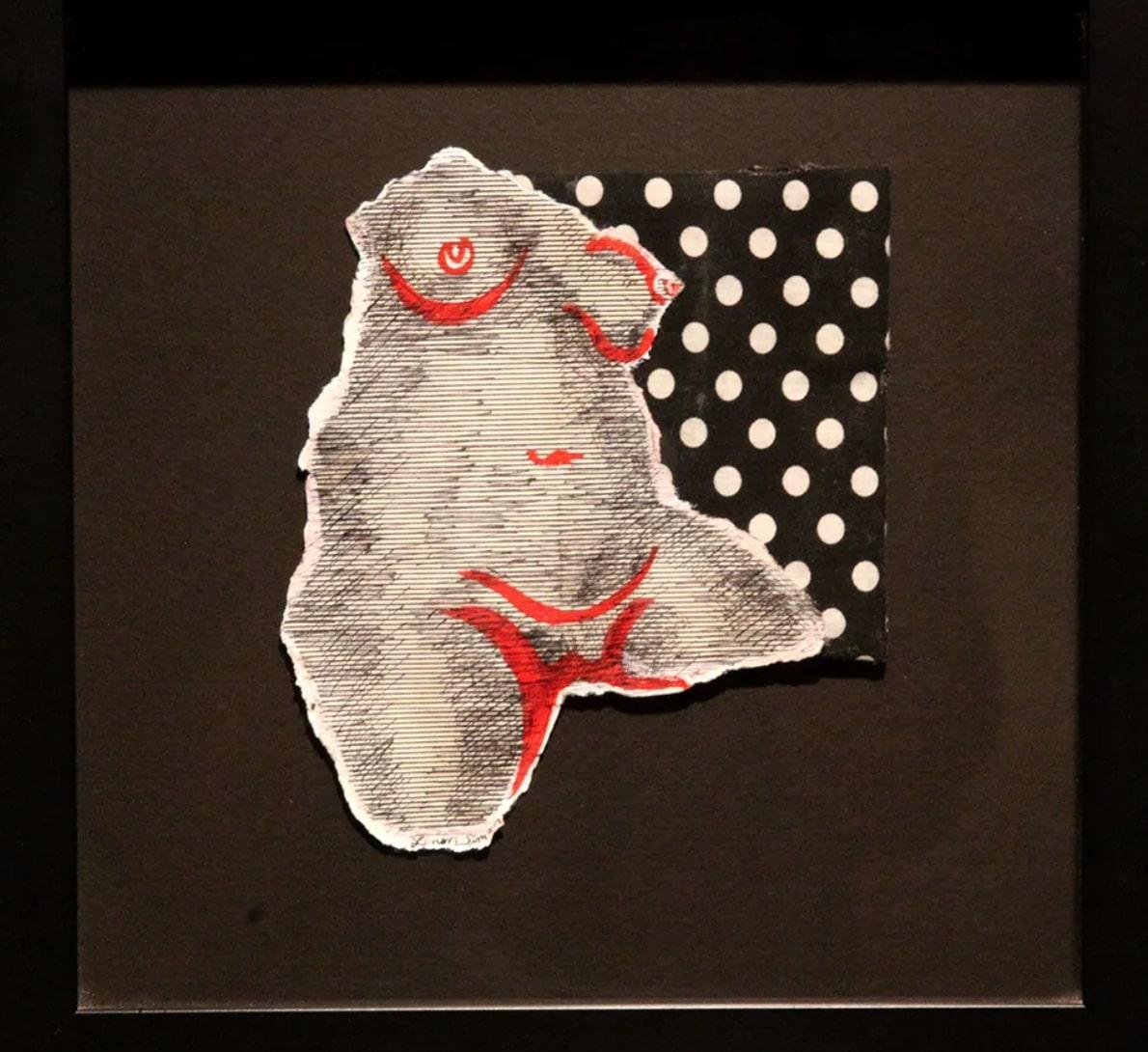Items Similar to The Scream
Want more images or videos?
Request additional images or videos from the seller
1 of 2
Gustav RehbergerThe Screamcirca 1950
circa 1950
About the Item
We are proud to present a just arrived series of original pen and ink and ink wash drawings by Austrian/American artist Gustav Rehberger. These works were acquired directly from the personal collection of the artist and family.
"The Scream", Pen and Ink Wash, Signed, c.1950.
- Creator:Gustav Rehberger (1910 - 1995, Austrian)
- Creation Year:circa 1950
- Dimensions:Height: 7 in (17.78 cm)Width: 8 in (20.32 cm)
- Medium:
- Movement & Style:
- Period:
- Condition:
- Gallery Location:West Hollywood, CA
- Reference Number:1stDibs: LU130157042
Gustav Rehberger
Gustav Rehberger was an Austrian-born American painter, draftsman, illustrator, designer, muralist and art educator. Rehberger is represented by Trigg Ison Fine Art, West Hollywood, California. He had solo shows at the Carnegie Hall Museum Benefit in 1992, Pompeii Museum, Monica North Galleries in 1992, Jacques Seligmann Gallery in New York City in 1977 and many others.
About the Seller
5.0
Vetted Seller
These experienced sellers undergo a comprehensive evaluation by our team of in-house experts.
Established in 1992
1stDibs seller since 2012
27 sales on 1stDibs
Typical response time: 13 hours
- ShippingRetrieving quote...Ships From: West Hollywood, CA
- Return PolicyThis item cannot be returned.
More From This SellerView All
- Man and the MountainBy Gustav RehbergerLocated in West Hollywood, CAWe are proud to present a just arrived series of original pen and ink and ink wash drawings by Austrian/American artist Gustav Rehberger. These works were acquired directly from the ...Category
1970s Expressionist Figurative Drawings and Watercolors
MaterialsInk
- Planting the StakeBy Gustav RehbergerLocated in West Hollywood, CAWe are proud to present a just arrived series of original pen and ink and ink wash drawings by Austrian/American artist Gustav Rehberger. These works were acquired directly from the ...Category
1970s Expressionist Figurative Drawings and Watercolors
MaterialsInk
- The Scream #1By Gustav RehbergerLocated in West Hollywood, CAWe are proud to present a just arrived series of original pen and ink and ink wash drawings by Austrian/American artist Gustav Rehberger. These works were acquired directly from the personal collection of the artist and family. "The Scream...Category
1940s Expressionist Figurative Drawings and Watercolors
MaterialsInk
- The AccordionistBy Byron RandallLocated in West Hollywood, CAAn exceptional original watercolor by American artist Byron Randall. "The Accordionist", is an original watercolor on heavy paper, signed, c.1945, ...Category
1940s Expressionist Figurative Paintings
MaterialsWatercolor
- ShadowsBy Béla Kádár, 1877-1955Located in West Hollywood, CAPresenting an original mixed media watercolor by Hungarian artist Bela Kadar. Bela Kadar was a historically important artist, is work was included as part of the degenerate art movement of Nazi Germany. His works appeared illustrated in the famous German arts magazine Der Sturm...Category
1920s Expressionist Figurative Paintings
MaterialsGouache
- PolynesiaBy Maurice GreenLocated in West Hollywood, CAPremiering for the first time in three decades, the original paintings of American artist Maurice Green. Born in 1908 in Latvia, Maurice Green studied with prominent artists of the d...Category
1940s Figurative Drawings and Watercolors
MaterialsInk
You May Also Like
- The Moonslayer - Parmis Sayous 21st Century drawing Iranian contemporary painterBy Parmis SayousLocated in Paris, FRPastel and India ink on cardboard Created in 2019 in Paris, France Unique work Signed by the artist Parmis Sayous was born in 1982 in Teheran, Iran. Since 2015, She has lived and wo...Category
2010s Expressionist Figurative Drawings and Watercolors
MaterialsPastel, India Ink, Cardboard
- Untitled - Parmis Sayous 21st Century drawing, Iranian contemporary painterBy Parmis SayousLocated in Paris, FRInk and pastel on canvas Created in 2019 in Paris, France Unique work Signed by the artist Parmis Sayous was born in 1982 in Teheran, Iran. Since 2015, She has lived and worked in P...Category
2010s Expressionist Figurative Drawings and Watercolors
MaterialsCanvas, Pastel, Ink
- Expressionist Figurative Drawing, "Striped Torso"Located in San Diego, CAThis is a one of a kind original expressionist figurative drawing by Southern California artist, Lenore Simon. It is framed as pictured. Its framed dimensions are 10"x10"x1.5". A cer...Category
2010s Expressionist Figurative Drawings and Watercolors
MaterialsInk, Fabric
- Original German Expressionist Drawing Ernst Ludwig Kirchner Women DancingBy Ernst Ludwig KirchnerLocated in Surfside, FLErnst Ludwig Kirchner ( Germany 1880-1938 ) Expressionist Female Women Dancing Mixed Media on Paper Drawing or Painting Expressionism Dimensions: 20" L 16" H in This bore a sticker from Christies auction house and another collection sticker verso but they have been inadvertently removed. I do have the photo. Ernst Ludwig Kirchner (1880 – 1938) was a German expressionist painter and printmaker and one of the founders of the artists group Die Brücke or "The Bridge", a key group leading to the foundation of Expressionism in 20th-century art. He volunteered for army service in the First World War, but soon suffered a breakdown and was discharged. His work was branded as "Entartete Kunst" or "degenerate" by the Nazis in 1933, and in 1937 more than 600 of his works were sold or destroyed. Ernst Ludwig Kirchner was born in Aschaffenburg, Bavaria. His parents were of Prussian descent and his mother was a descendant of the Huguenots, a fact to which Kirchner often referred. As Kirchner's father searched for a job, the family moved frequently and Kirchner attended schools in Frankfurt and Perlen until his father earned the position of Professor of Paper Sciences at the College of technology in Chemnitz, where Kirchner attended secondary school. Although Kirchner's parents encouraged his artistic career they also wanted him to complete his formal education so in 1901, he began studying architecture at the Königliche Technische Hochschule (royal technical university) of Dresden. The institution provided a wide range of studies in addition to architecture, such as freehand drawing, perspective drawing and the historical study of art. While in attendance, he became close friends with Fritz Bleyl, whom Kirchner met during the first term. They discussed art together and also studied nature, having a radical outlook in common. Kirchner continued studies in Munich from 1903 to 1904, returning to Dresden in 1905 to complete his degree. In 1905, Kirchner, along with Bleyl and two other architecture students, Karl Schmidt-Rottluff and Erich Heckel, founded the artists group Die Brücke ("The Bridge") later to include Emil Nolde, Max Pechstein and Otto Mueller. From then on, he committed himself to art. The group aimed to eschew the prevalent traditional academic style and find a new mode of artistic expression, which would form a bridge (hence the name) between the past and the present. They responded both to past artists such as Albrecht Dürer, Matthias Grünewald and Lucas Cranach the Elder, as well as contemporary international avant-garde movements. As part of the affirmation of their national heritage, they revived older media, particularly woodcut or woodblock prints. Kirchner's studio became a venue which overthrew social conventions to allow casual love-making and frequent nudity. Group life-drawing sessions took place using nude models from the social circle, rather than professionals, and choosing quarter-hour poses to encourage spontaneity. In 1911, he moved to Berlin, where he founded a private art school, MIUM-Institut, in collaboration with Max Pechstein with the aim of promulgating "Moderner Unterricht im Malen" (modern teaching of painting). This was not a success and closed the following year, when he also began a relationship with Erna Schilling that lasted the rest of his life. In 1917, at the suggestion of Eberhard Grisebach [de], Helene Spengler invited Kirchner to Davos where he viewed an exhibition of Ferdinand Hodler paintings. "When I was leaving, I thought of Vincent Van Gogh's fate and thought that it would be his as well, sooner or later. Only later will people understand and see how much he has contributed to painting". In 1921 Kirchner visited Zurich at the beginning of May and met the dancer, Nina Hard, whom he invited back to Frauenkirch (despite Erna's objections). Nina Hard would become an important model for Kirchner and would be featured in many of his works. Kirchner began creating designs for carpets which were then woven by Lise Gujer. In 1925, Kirchner became close friends with fellow artist, Albert Müller...Category
Early 20th Century Expressionist Figurative Drawings and Watercolors
MaterialsInk, Paper
- Expressionist Color Drawing Cobalt Glass Vintage Frame Modernist Ben Zion WPABy Ben-Zion WeinmanLocated in Surfside, FLExpressionist ink and pastel crayon drawing of flowers in vase. Framed in a vintage cobalt blue glass original frame Hand signed and dated Framed it measures 13.5 X 10.5 The actual paper is 7.5 X 5.5 Born in 1897, Ben-Zion Weinman celebrated his European Jewish heritage in his visual works as a sculptor, painter, and printmaker. Influenced by Spinoza, Knut Hamsun, and Wladyslaw Reymont, as well as Hebrew literature, Ben-Zion wrote poetry and essays that, like his visual work, attempt to reveal the deep “connection between man and the divine, and between man and earth.” An emigrant from the Ukraine, he came to the US in 1920. He wrote fairy tales and poems in Hebrew under the name Benzion Weinman, but when he began painting he dropped his last name and hyphenated his first, saying an artist needed only one name. Ben-Zion was a founding member of “The Ten: An Independent Group” The Ten” a 1930’s avant-garde group, Painted on anything handy. Ben-Zion often used cabinet doors (panels) in his work. Other members of group included Ilya Bolotowsky, Lee Gatch, Adolph Gottlieb, Louis Harris, Yankel Kufeld, Marcus Rothkowitz (later known as Mark Rothko), Louis Schanker, and Joseph Solman. The Art of “The Ten” was generally described as expressionist, as this style offered the best link between modernism and social art. Their exhibition at the Mercury Gallery in New York held at the same time as the Whitney Annual Exhibition of Contemporary American Painting, included a manifesto concentrating on aesthetic questions and criticisms of the conservative definition of modern art imposed by the Whitney. Ben-Zion’s work was quickly noticed. The New York Sun said he painted “furiously” and called him “the farthest along of the lot.” And the triptych, “The Glory of War,” was described by Art News as “resounding.” By 1939, The Ten disbanded because most of the members found individual galleries to represent their work. Ben-Zion had his first one-man show at the Artist’s Gallery in Greenwich Village and J.B. Neumann, the highly esteemed European art dealer who introduced Paul Klee, (among others) to America, purchased several of Ben-Zion’s drawings. Curt Valentin, another well-known dealer, exhibited groups of his drawings and undertook the printing of four portfolios of etchings, each composed of Ben-Zion’s biblical themes. He worked as a WPA artist. Ben-Zion’s work is represented in many museums throughout the country including the Metropolitan, the Whitney, and the Museum of Modern Art in New York, the Art Institute of Chicago, the Philadelphia Museum of Art and the Phillips Collection, Washington. The Jewish Museum in New York opened in 1948 with a Ben-Zion exhibition. Ben-Zion consistently threaded certain subject matter—nature, still life, the human figure, the Hebrew Bible, and the Jewish people—into his work throughout his life. "In all his work a profound human feeling remains. Sea and sky, even sheaves of wheat acquire a monolithic beauty and simplicity which delineates the transient as a reflection of the eternal. This sensitive inter- mingling of the physical and metaphysical is one of the most enduring features of Ben-Zion's works." (Excerpt from Stephen Kayser, “Biblical Paintings,” The Jewish Museum Catalogue, 1952). Mystical Imprints: Marc Chagall, Ben-Zion, and Ben Shahn presents the print work of three prominent 20th century Jewish artists born in the Russian Empire. Among these seventy pieces are etchings and lithographs from Chagall’s Bible series...Category
1950s Expressionist Still-life Drawings and Watercolors
MaterialsPaper, Oil Crayon, Pastel, Ink
- Expressionist Miniature Drawing Wheat Stalks American Modernist Ben Zion WPABy Ben-Zion WeinmanLocated in Surfside, FLExpressionist ink drawing of wheat stalks There is an inscription "Happy New Year" on verso Hand signed Framed it measures 7.75 X 5.75 The actual paper is 3 X 3.5 Born in 1897, Ben-Zion Weinman celebrated his European Jewish heritage in his visual works as a sculptor, painter, and printmaker. Influenced by Spinoza, Knut Hamsun, and Wladyslaw Reymont, as well as Hebrew literature, Ben-Zion wrote poetry and essays that, like his visual work, attempt to reveal the deep “connection between man and the divine, and between man and earth.” An emigrant from the Ukraine, he came to the US in 1920. He wrote fairy tales and poems in Hebrew under the name Benzion Weinman, but when he began painting he dropped his last name and hyphenated his first, saying an artist needed only one name. Ben-Zion was a founding member of “The Ten: An Independent Group” The Ten” a 1930’s avant-garde group, Painted on anything handy. Ben-Zion often used cabinet doors (panels) in his work. Other members of group included Ilya Bolotowsky, Lee Gatch, Adolph Gottlieb, Louis Harris, Yankel Kufeld, Marcus Rothkowitz (later known as Mark Rothko), Louis Schanker, and Joseph Solman. The Art of “The Ten” was generally described as expressionist, as this style offered the best link between modernism and social art. Their exhibition at the Mercury Gallery in New York held at the same time as the Whitney Annual Exhibition of Contemporary American Painting, included a manifesto concentrating on aesthetic questions and criticisms of the conservative definition of modern art imposed by the Whitney. Ben-Zion’s work was quickly noticed. The New York Sun said he painted “furiously” and called him “the farthest along of the lot.” And the triptych, “The Glory of War,” was described by Art News as “resounding.” By 1939, The Ten disbanded because most of the members found individual galleries to represent their work. Ben-Zion had his first one-man show at the Artist’s Gallery in Greenwich Village and J.B. Neumann, the highly esteemed European art dealer who introduced Paul Klee, (among others) to America, purchased several of Ben-Zion’s drawings. Curt Valentin, another well-known dealer, exhibited groups of his drawings and undertook the printing of four portfolios of etchings, each composed of Ben-Zion’s biblical themes. He worked as a WPA artist. Ben-Zion’s work is represented in many museums throughout the country including the Metropolitan, the Whitney, and the Museum of Modern Art in New York, the Art Institute of Chicago, the Philadelphia Museum of Art and the Phillips Collection, Washington. The Jewish Museum in New York opened in 1948 with a Ben-Zion exhibition. Ben-Zion consistently threaded certain subject matter—nature, still life, the human figure, the Hebrew Bible, and the Jewish people—into his work throughout his life. "In all his work a profound human feeling remains. Sea and sky, even sheaves of wheat acquire a monolithic beauty and simplicity which delineates the transient as a reflection of the eternal. This sensitive inter- mingling of the physical and metaphysical is one of the most enduring features of Ben-Zion's works." (Excerpt from Stephen Kayser, “Biblical Paintings,” The Jewish Museum Catalogue, 1952). Mystical Imprints: Marc Chagall, Ben-Zion, and Ben Shahn presents the print work of three prominent 20th century Jewish artists born in the Russian Empire. Among these seventy pieces are etchings and lithographs from Chagall’s Bible series...Category
1950s Expressionist Still-life Drawings and Watercolors
MaterialsInk
Recently Viewed
View AllMore Ways To Browse
Collection Of The Artist
The Scream
The Scream Art
Vintage Scream
Screaming Painting
Scream Painting
The Scream Painting
Original The Scream
20th Century Japanese Watercolor Painting
Gold Ink Pen
La Poesie
Antique Pen Ink Drawings
Vintage Figure Drawings
Antique Pen And Ink Drawings
Xix Century Painting
Antique Drawing Board
Vintage Fox Drawing
Francis Bacon Signed
